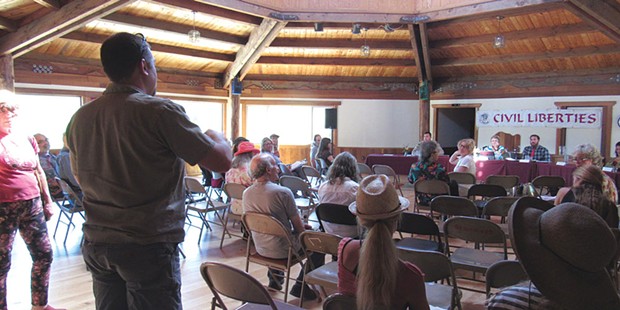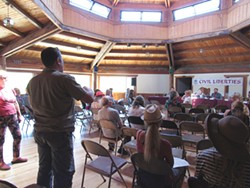The Taxman Cometh
SoHum growers mull trusting, paying the Man
By Linda Stansberry [email protected] @lcstansberry[
{
"name": "Top Stories Video Pair",
"insertPoint": "7",
"component": "17087298",
"parentWrapperClass": "fdn-ads-inline-content-block",
"requiredCountToDisplay": "1"
}
]
Public comment during last Tuesday's Board of Supervisors meeting stretched close to two hours, as many small growers turned up to protest a proposed excise tax. While county staff had originally recommended a tiered system in which taxes scale up with grow sizes, topping out at $6 per square foot for a 10,000-square-foot indoor grow, the tax was slashed twice during subsequent board meetings, first by a full 25 percent, then to $1/$2/$3 per square foot for outdoor, mixed light and indoor grows, respectively. Some say this change will unfairly penalize small producers whose cost-to-yield ratio will be higher than those with larger operations. Alex Moore, first in the county to have a permitted "megagrow," was one of the lone speakers to express approval for the measure. Moore's operation, Honeydew Farms LLC, has been approved to expand from 1 to 7 acres.
"We need the money in this industry," said Moore during public comment, adding with a chuckle that the urging of some to wait until 2018, when state permits will become available, to enforce taxes "sounds good" to him, but he doubted the board would wait that long.
And it doesn't appear it will. The board approved the ballot measure to go up for a vote in November, with Supervisor Ryan Sundberg noting it can "fine tune" some details at a later date. He and others said there had been ample time for public input on the tax measure, and that the item needed immediate approval in order to make it onto the ballot.
"We need the funds," said Supervisor Estelle Fennell. "There are not many changes we can make today."
The excise tax is estimated to insert $7.3 million into the county general fund for "public safety, job creation; crime investigation/prosecution; environmental cleanup/restoration; children/family mental health and drug rehabilitation." The estimate is based on the projected registration of 400 grows; to date, the county has received 108 applications and approved two. Seven million dollars might sound like a hefty figure, but on the scale of the costs of running a county, it breaks down to around 2 percent of Humboldt's 2016-2017 budget. For some perspective, the county currently has $200 million in deferred road repairs alone.
For growers hoping to become compliant with the county's medical marijuana ordinance, the tax comes on top of what some are saying is an onerous financial burden for certification. Application fees are a couple thousand dollars, with additional money out the door for engineering, consultancy and bringing facilities up to code. The specter of additional state taxes and the county's requirement that distribution be separated from cultivation (distributors are currently requesting 20 to 35 percent of gross receipts from sales) cut further into what used to be a lucrative bottom line.
"For those of you seeking a carrot to bring people in, this seems awfully like a stick," said Danielle Burkhart during public comment.
Burkhart, a consultant with Emerald Heritage Farms, later expanded on her comments in a phone interview.
"I'm seeing that if you're under roughly 10,000 square feet, in the 2,000- to 6,000-square-foot range, you're going to be hit hardest by this," she said, adding that consultancy alone can cost around $8,000. "Certification is costly. There are no loans for this. The idea of [growers] raking in the cash is a stereotype."
Still, she acknowledges that the ballot measure will probably pass.
"I think you put tax and cannabis in the same ballot, it's a no brainer. People are going to vote for it," she said, adding that small growers are a relatively small voting bloc. The changes to the tax ordinance might be another obstacle in the path of county officials who are trying to convince members of a traditionally insular and suspicious industry to come out into the light. This was apparent in a recent community meeting in Southern Humboldt, where Fennell brought in representatives from the county planning department, sheriff's office, water quality and California Department of Fish and Wildlife to address concerns from residents.
The July 22 meeting, held at Beginnings in Briceland, was sponsored by the Civil Liberties Monitoring Project. Around 40 community members came to ask questions, most centering around the tension between small "heritage" growers and larger growers who arrived during the "Green Rush." Steve Lazar, a senior planner with the county, said the crowd was very different from the one that attended a compliance workshop he held the week prior. At that time, he said, the parking lot was full of trucks with out-of-state license plates.
Fennell and Lazar, who were present at a larger and much rowdier meeting in Bridgeville last month, acknowledged that there were challenges inherent in regulating the industry.
"It's going to be a frustrating situation for a couple of years," said Lazar. "In the meanwhile, hopefully, we can address some of the most egregious problems."
Those egregious problems, as submitted by the CLMP prior to the meeting, include wear and tear to shared access roads, illegal water diversions, noise and light pollution, and the perceived preferential treatment of bigger growers over mom-and-pops "being swept up in an avalanche of regulations, fees and costs."
Several people expressed fear of being dinged for incidental code violations should they invite representatives from the planning department onto their properties.
"When you apply for a cannabis permit you don't need to fix every little thing," said Lazar, who also said larger grows would be under greater scrutiny. "The bigger you are, the faster you should come into compliance."
Very well, said the crowd, but who is actually enforcing compliance? Next year growers will be subject to an annual inspection (incurring another fee to the county). In the meantime, there are thousands of illegal grows, many on sites that have been illegally graded, that are using streams and rivers for their water sources, with generators roaring through the night and day, and with no money coming in to adequately enforce them.
"I tracked down 15 different generators in my neighborhood," said George Holper, who said she is no longer able to sit peacefully in her front yard. "Actually, I heard yours, Estelle."
"Yes, I like to watch TV at night," murmured Fennell, who is a Redway resident.
Actually, Lazar said, there is specific language in the ordinance to address both noise and light pollution. If your neighbor's grow is legal, the county will, at some point, be able to come in and shut down the noise. And if the grow is illegal? Ostensibly, after Jan. 1, 2017, the ordinance will allow law enforcement to separate the bad actors from the good ones. In the meantime, community members are still encouraged to call a tip line. Complaints will be directed to the sheriff's office, water quality or CDFW as necessary. Several people at the meeting expressed unease at the increased scrutiny and the idea of going on record about their existing operations. (The sheriff's office will use satellite images to monitor whether a grow has sprung up or expanded post-registration.)
"So, this means we're admitting to past illegal activity?" asked one audience member.
"Yes," said Undersheriff Billy Honsal with a small smile. "You're having faith in a system."
A bout of nervous chuckling roiled the audience.
"We know you're doing it anyway," continued Honsal, adding that his officers had served warrants on several properties that claimed to be growing medical marijuana but hadn't had proof. The plants were cut and the district attorney is pressing charges.
"Good!" said one woman.
"We are complaint-driven," said Honsal. "We need you to complain to us, not your neighbors. I wish we had 15 to 20 deputies assigned to this. The reality is we have five. Become a police helper. Help us."
At this, the chuckles bubbled up again, but when the tip line number was repeated, people scrambled to write it down. Lazar says his department has received 13 complaints to date.
"I'm not saying it's going to be easy," said Lazar. "But we're getting the dialogue started."
more from the author
-
Lobster Girl Finds the Beat
- Nov 9, 2023
-
Tales from the CryptTok
- Oct 26, 2023
- More »
Latest in News
Readers also liked…
-
Through Mark Larson's Lens
A local photographer's favorite images of 2022 in Humboldt
- Jan 5, 2023
-
'To Celebrate Our Sovereignty'
Yurok Tribe to host gathering honoring 'ultimate river warrior' on the anniversary of the U.S. Supreme Court ruling that changed everything
- Jun 8, 2023


































